Eczema (or Dermatitis) is a common problem that causes the skin to become inflamed, irritated and itchy. It is estimated that eczema affects approximately 31 million people and about 20 percent of the children under the age of 10 living in the US with degrees of intensity: mild, moderate, and severe.

There are actually seven different types of eczema:
- Atopic Dermatitis: The most prevalent and commonly known as just eczema.
- Nummular Dermatitis: Or discord eczema characterized by coin like lesions.
- Contact Dermatitis – Two types: Allergic Dermatitis and Irritant Dermatitis.
- Hand Eczema: Also is known as hand washing eczema, common for people who frequently wash their hands with harsh soap.
- Dyshidrotic Eczema: More common in women than men.
- Neurodermatitis: Often stress induced trigger - typically affects people who have other types of eczema and is characterized by intense itching in specific areas of the body like the neck, wrists, forearms, legs or anal region.
- Stasis Dermatitis: Typically caused by blood flow (circulation) problems.
What causes eczema?
This is a bit of a trick question since flareup triggers are often confused with the root cause of eczema and there is no single answer when discussing flareup triggers since there is a wide range of eczema flareup causes and eczema seems to define itself differently in almost every individual. In 2006 researchers
finally identified what is now accepted as the root cause for eczema:
- Eczema Cause: Eczema is caused by the skin’s inability to naturally repair damage to the skin barrier due to a genetic deficiency of a protein in the skin cells called “filaggrin”. The damaged skin barrier allows an increase in Trans Epidermal Water Loss (TEWL) or moisture to escape, making the skin abnormally dry, flakey crusty and scaly. The dry skin allows environmental irritants to enter the skin activating the immune system, producing red, itchy inflamed skin.
- Eczema Flareups: there are literally thousands of flareup triggers including dietary issues and food allergies such as dairy, gluten, eggs, peanuts, etc.; airborne pollutants and contaminants like smoke, dust, pet dander, and pollen; humidity – both hot wet air and dry cold air; emotional stress and many others. One of the things that makes eczema so difficult to manage is that the real issue is that typically people with eczema have a diverse combination of triggers and are statistically (60% of children that have a family history of allergies such as hay fever and/or asthma are more likely to have eczema) likely to have asthma and/or hay fever. Medical professionals call this the atopic triad.
- Symptoms: There is a myriad of common irritated and sensitive skin symptoms which crossover in varying degrees between all seven types of eczemas. You can read more about specific eczema type symptoms at our blog on types of eczema. Typically people with mild, moderate and severe eczema all experience some level of red, irritated skin rashes that are sometimes sensitive to the touch; and all three frequently people experience hot, burning sensations and itchiness; blisters, pimples, weeping sores; and dry, flakey skin, and crusted over scales.
How can I tell if my eczema is infected?
Infected weeping eczema symptoms include:
- The honey-colored crusty skin develops tiny blisters that contain clear fluid that starts to leak, ooze or weeping from the affected skin. This is a very common form of staph infection and usually develops with eczema-affected skin that’s open and “weepy. Eczema is not contagious but this kind of staph infection is very contagious, but also easily treated. Containment is important to consult a medical professional for treatment before it spreads to other parts of the body.
- Lesions (sores or boils) with red/yellow pus-filled bumps (pustules) form on the skin and can break open and “weep” or ooze fluid.
- A fever or elevated body temperature, with flu-like symptoms or swollen glands in the armpit, neck, and groin can also be symptoms of infected eczema skin.
Natural and Holistic Treatments for Infected Weeping Eczema Management:
Weeping eczema and the possibility of a skin infection is very serious and needs to immediate attention. This blog article is not meant to serve as a professional medical opinion or medical advice. It is always best to consult your health care provider or dermatologist immediately if you suspect you have a skin infection. There are many reasons why the infection has started but the side effects can be dangerous.
Apple Cider Vinegar: Natural and Holistic Eczema Treatment for Moderate to severe Eczema in eczema infections.
Apple Cider Vinegar or ACV is an excellent natural astringent that helps balance the skins pH levels of the skin acting as an antibacterial and anti-fungal solvent. ACV is a natural antioxidant and contains all kinds of immune-boosting vitamins including Vitamin B1 riboflavin, sulfur, acetic acid and mineral salts that are good for calming inflammation and repairing damaged skin tissue. Studies have found that apple cider vinegar helps fight Staphylococcus aureus bacteria, and also Escherichia coli and could help keep broken skin from becoming infected. Remember to always use a highly diluted solution of ACV and water when treating skin rashes and infection.
We recommend using organic, raw, unfiltered Braggs apple cider vinegar (Naturally Gluten Free - Certified Non-GMO) which is readily available at most grocery stores and is relatively inexpensive to use.
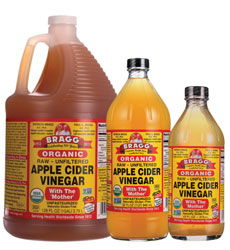
Here a few simple at-home practices using Apple Cider Vinegar that can help prevent and treat eczema infections:
- Apple Cider Vinegar baths – Dermatologists agree that taking frequent therapeutic baths helps add moisture back into the skin and can be an especially effective therapy method for baby eczema. Follow these simple directions and you will be amazed at much better eczema skin will look and feel.
- Prepare a lukewarm bath and add up to 2 cups for Add 2 cups of apple cider vinegar to the warm bathwater.
- Soak for 15–20 minutes. Don’t overdo it, limit the time in each bath session, but taking more than one bath per day can be beneficial.
- Rinse the body thoroughly with clear water washing off the residual ACV. This is important for several reasons but ACV does have a slight inherent natural odor.
- Pat dry the skin using a soft cotton terry towel. Avoid rubbing the skin when drying off. Don't worry too much about getting completely dry, leaving the skin slightly damp is a good tip.
- Generously moisturize the skin immediately after drying off.
- Cover the moisturized skin with eczema clothing like Soothems. The special skin smart fabric of Soothems offers many important benefits for treating eczema. The TENCEL™ - fibers with Chitosan embedded permanently inside the fibers will help regulate skin temperature, help control the spread of bacteria and start helping the skin’s natural barrier to protect itself. The zinc oxide that is bonded to the fabric is an excellent astringent and will help calm the itching and reduce skin inflammation.
- Repeat ACV baths 4 - 5 times per week during flareups.
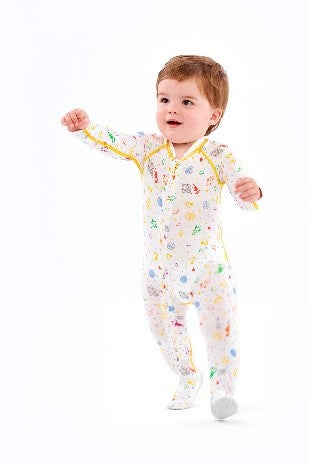 2. Wet Wrapping is a dermatologist recommended, highly effective method for treating eczema and adding moisture back into the skin, calming itchiness and soothing irritated skin. Try this new benefit to wet wrapping by adding Apple Cider Vinegar to wet wraps.
2. Wet Wrapping is a dermatologist recommended, highly effective method for treating eczema and adding moisture back into the skin, calming itchiness and soothing irritated skin. Try this new benefit to wet wrapping by adding Apple Cider Vinegar to wet wraps.
- Don’t use regular cotton for wet wrapping. Cotton (regardless of whether organic or not) is not a good fabric for wet wrapping. Cotton tends to be cold, clammy and soaking wet and it sags out of shape so it does not stay close to the skin, helping to reapply moisture. Cotton can also breed more bacteria than it will ever stave off. Use eczema sleepwear made from skin smart fabric that has been designed for wet wrapping therapy likeSoothems. Using Soothems you combine the best of textile science that includes TENCEL™ fibers with Chitosan and zinc oxide.
- Create a mixture of water and apple cider vinegar using the ratio of 1 cup of warm water and 1 tablespoon of ACV.
- Submerge the Sootehms garments in the mixture so they can absorb the water and apple cider vinegar. Another benefit from using eczema sleepwear from Sootehms is that the fabric absorbs 50% of its weight in water because of the hollow Tencel fibers. remove some of the excess water without ringing out the garment so it remains damp.
- Moisturize the skin using a thick emollient like Vaniply.
- Dress with the damp Soothems snugly next to eczema skin.
- Cover the damp Soothems in dry regular pajamas. The fiber content of this second layer is not as important as Soothems next to the skin. Many caregivers have found that polyester or modacrylic pajamas are better than cotton as they do not absorb moisture the way cotton does, expediting the dry time of the Soothems.
- Leave both layers on the eczema rash for 3 hours.
- After removing the wet wrap we suggest either leaving the Soothems on or putting a fresh pair on so the skin stays soft and moisturized.
Before and After Wet Wrapping Results:
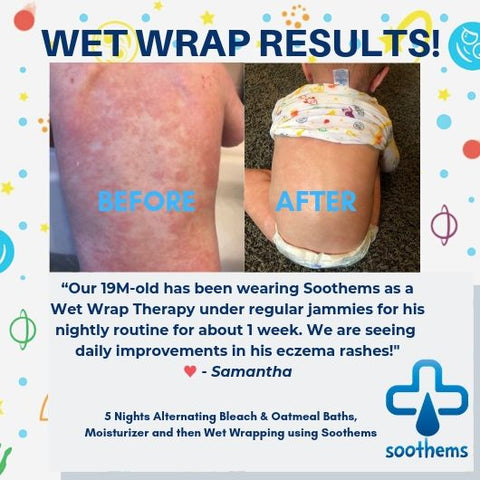
Weeping Eczema Treatments: Conclusion
Getting in front of an eczema flareup, as soon as early signs are recognized, can impact the severity and length of discomfort from eczema itchiness and burning, dry, irritated skin rashes. Start with therapeutic lukewarm 15 minutes baths, moisturize immediately after and put on eczema clothing or eczema sleepwear from Soothems. Following this simple regime can make a big difference. And if there are any suspicious signs of an infection forming on the eczema rash seek the advice of your dermatologist about treatment. Letting a weeping eczema infection go too long can lead to many other complications. Remember eczema is not contagious but spreading bacteria from an eczema infection is possible.

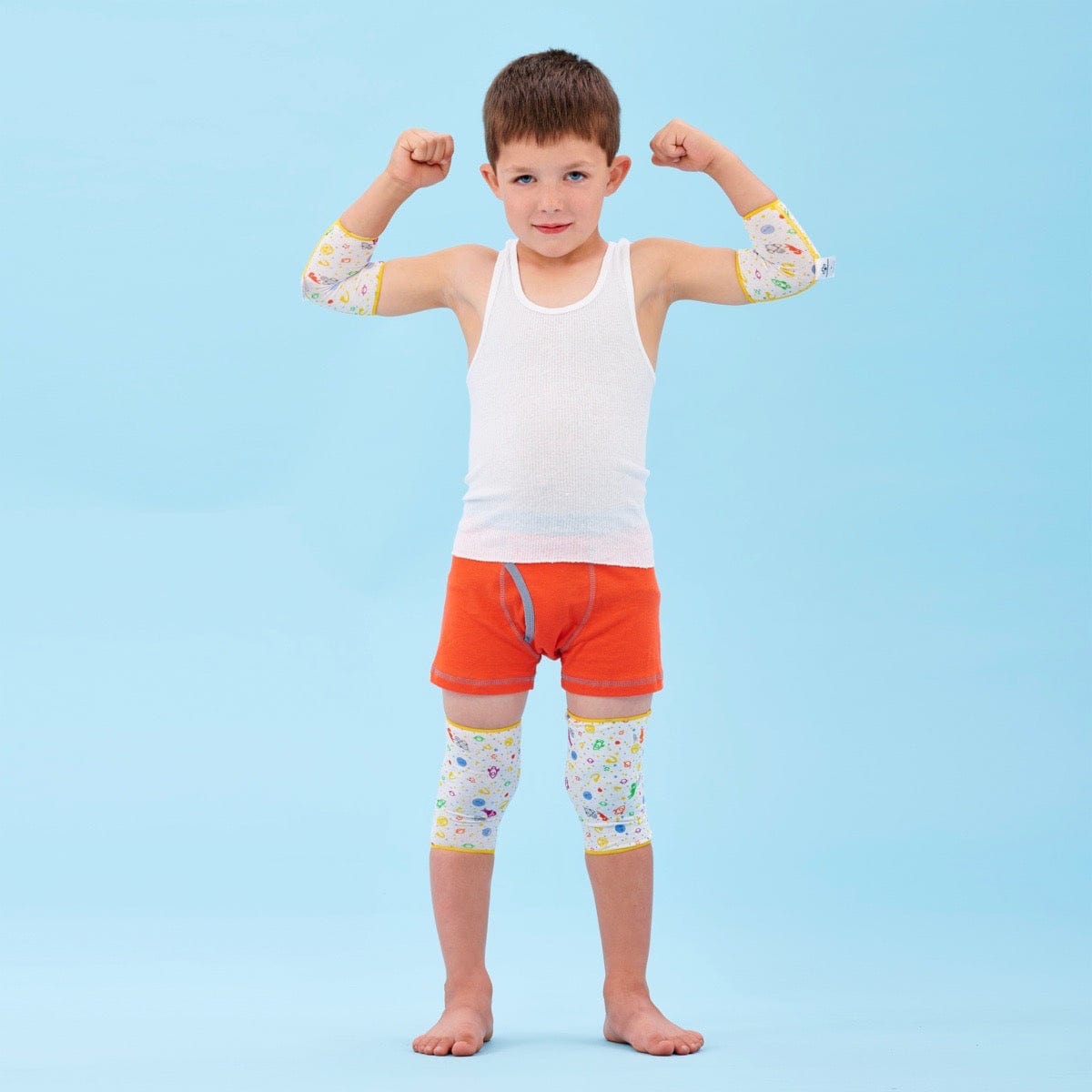


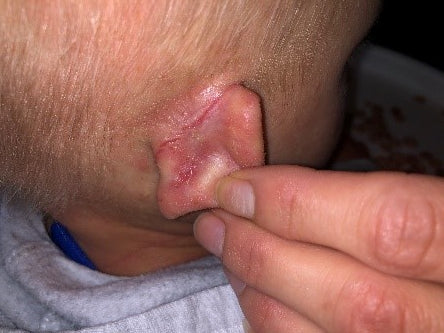
Leave a comment
All comments are moderated before being published.
This site is protected by hCaptcha and the hCaptcha Privacy Policy and Terms of Service apply.